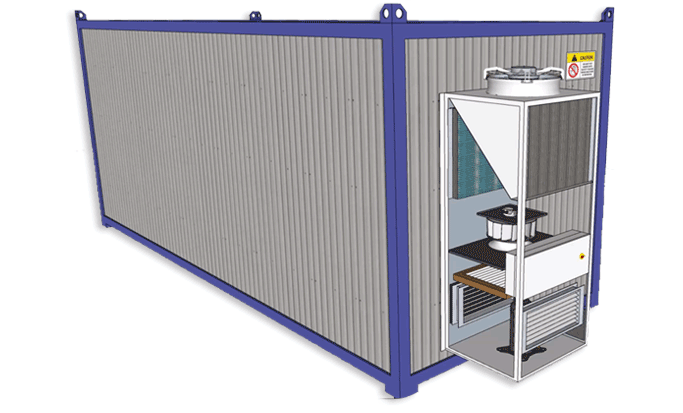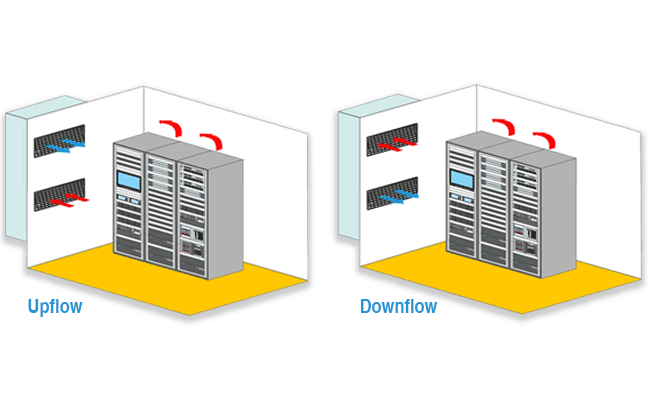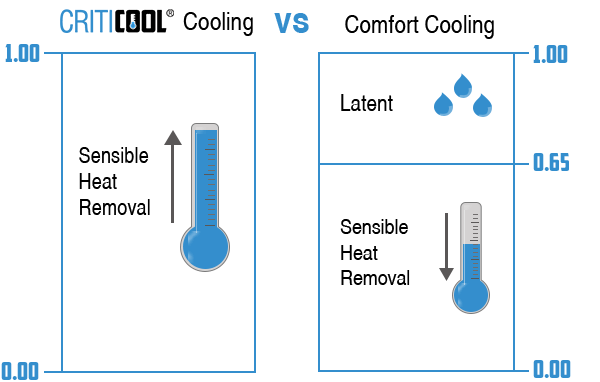DX Cooling Systems
The Direct Expansion (DX) Cooling System is a highly efficient, reliable and economically-friendly IT cooling solution for pre-fabricated modular data centers.
DX Cooling Systems
The Direct Expansion (DX) Cooling System is a highly efficient, reliable and economically-friendly IT cooling solution for pre-fabricated modular data centers.
Container Cooling: Modular DX Cooling Applications
The DX Cooling System's mission critical design is a result of 50+ years of experience by Mitsubishi Electric in the telecommunication field, where systems must run 24/7. Rather than modify a comfort cooling device, the DX Cooling Systems were developed specifically for cooling modular structures containing auxiliary backup power supplies and IT equipment, frequently serving as a bolt-on to existing data centers or enterprise IT facilities.
The first solution in our CritiCool® product line is the DX Cooling System: a fully assembled, packaged cooling solution that mounts to the wall of a container unit with up- or downflow configuration options. The integral air-cooled condensers are designed for outdoor installation, making the DX-Ps ideal for container cooling.
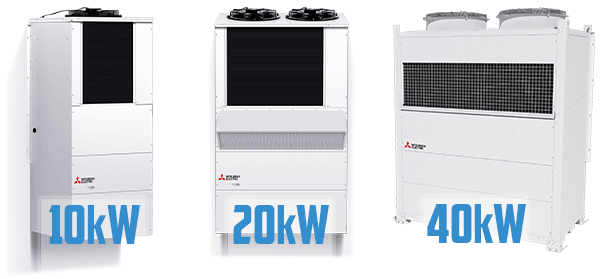
DX Cooling System Features & Benefits
Materials used in fabrication of our wall-mounted direct expansion cooling units have been selected to withstand exposure to ambient weather conditions and are compatible with outdoor air temperatures from 0°F (-18°C) to 125°F (52°C). An optional “Economizer” (or "Free Cooling") package extends functionality to -40°F (-40°C).
The DX-P cooling system's revolutionary design offers three nominal capacities (34,100 Btu/h - 149,000 Btu/h [10 kW, 20kW, and 40kW]) with two configurations each (upflow and downflow1) and can be equipped with an on/off or inverter-based compressor1 for improved power usage effectiveness (PUE).
1For the 10kW and 20kW models only. The 40kW system is currently only offered in downflow and inverter compressor.
Smart Design
Supplied fully assembled, DX-P cooling units are available in two configurations: upflow and downflow (over/under). Both solutions enjoy the added value granted by the location of the "free cooling" suction away from the hot exhaust air flow (positioned on top of the unit), avoiding any recirculation of hot air.
Mitsubishi Electric's innovative downflow version capitalizes on the natural hot, warm, and cold air to provide warmer air to the evaporator and then reduce the cold air recirculation.
This is a first in the U.S. market and creates higher efficiencies in heat management.
The four possible modes of operation include (1) Mechanical Cooling, (2) Mechnical & Free Cooling, (3) Free Cooling, and (4) Free Cooling & Mixing.
Advanced Cooling Technology
In a typical IT application, a Sensible Heat Ratio (SHR)* of 0.95 indicates that 95% of the energy power engaged by the compressor is used for Sensible Heat Removal, with the remaining 5% used for removing humidity.
With Mitsubishi Electric's DX Cooling Systems' SHR of up to 1.0, 100% of the energy power supplied by the compressor is used for Sensible Heat Removal.
This is in contrast to systems designed for comfort cooling that work to reduce air temperature and remove humidity in the environment.
An electrical/IT environment has minimal need for dehumidification, so employing a comfort cooling system creates an inefficient use of energy and increases your total cost of ownership (TCO).
When you install a DX-P cooling unit, you're deploying a more energy- and cost-efficient DX cooling solution ideal for maintaining uptime in a modular data center.
High Efficiency Direct Expansion Cooling for IT
The combination of these advanced technologies and smart designs delivers a highly efficient DX Cooling Solution. With the highest SHR in the US market for this application, and an equivalent footprint when compared to lower SHR competitors,
Mitsubishi Electric's DX models earn one of the highest Energy Efficiency Ratio (EER) in the U.S. market at 11.90.
The high Sensible Cooling Capacity (SCC) of our DX Cooling Systems can reduce the number of units necessary to contrast the heat load generated in an electrical environment.
Requiring less units not only lowers your capital expenditures, but also lowers energy consumption. These realized efficiencies will lower your operating expenses and reduce energy consumption.
Deployments utilizing our inverter-driven cooling systems will see gains in efficiency and air movement, as the system will respond to the load demand from the environment.
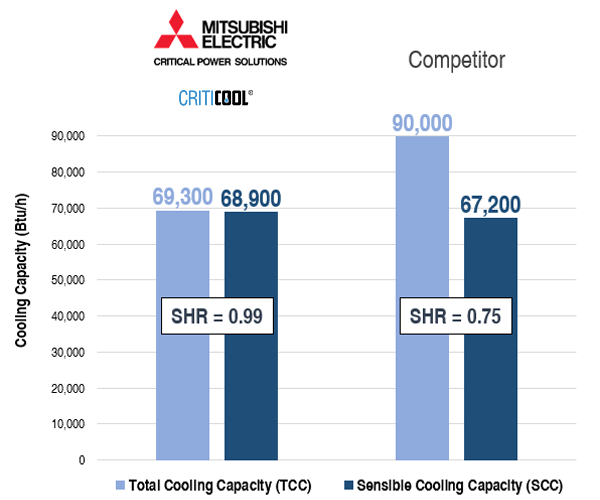
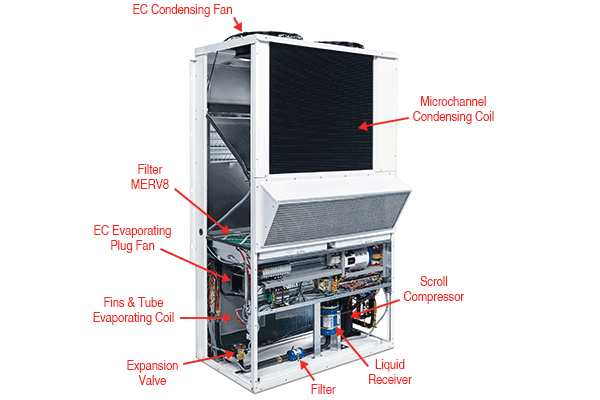
Easy Install & Maintenance
With full frontal accessibility, Mitsubishi Electric's DX-P Cooling units are built to ease the inspection and maintenance processes.
They come fully assembled for easy installation, and the limited parts list and remote alarm capabilities reduce the need for constant management and monitoring of the system.
When you need a reliable DX Cooling Solution that requires minimal upkeep - ideal for remote installs - trust the critical power experts at Mitsubishi Electric.
Sophisticated Controls
Each DX Cooling unit comes standard with a high-speed microprocessor controller. By utilizing a Local Area Network (LAN), your modular buildings can have up to 15 DX units working together as one system.
With each DX unit having a controller, the need for a centralized controller that manages all the cooling units is eliminated.
A small remote terminal can be installed in its place which will provide current conditions of the system.
LAN features:
- Balancing the operating hours among the different units by rotating the reserve units
- Turning on reserve units in the event of alarms, maintenance, power loss, or excessive thermal load
- DYNAMIC MASTER function, making the role of the Master unit dynamic. In other words, losing one DX unit does not bring down the entire system.
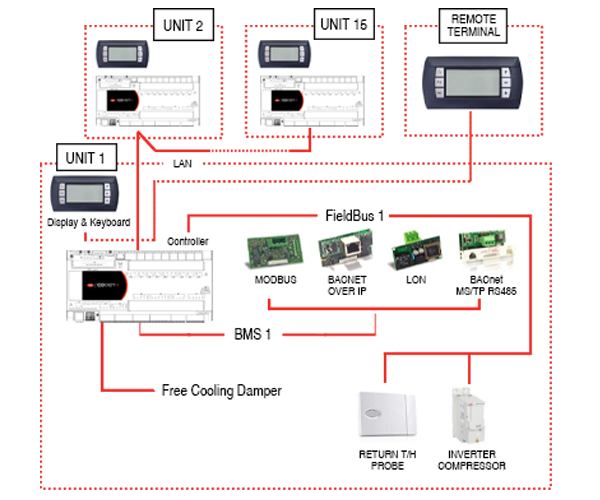
To learn more about the DX-P model
To explore IT Cooling resources
To discuss your project and application
*SHR = Sensible Cooling Capacity / Total Cooling Capacity
- Total Cooling Capacity measures the energy supplied by the compressor and is calculated as the Sensible Cooling Capacity + Latent Capacity
- Sensible Cooling Capacity measures the energy supplied for controlling/reducing the air temperature
- Latent Cooling Capacity measures the energy supplied for removing humidity from the air moisture
